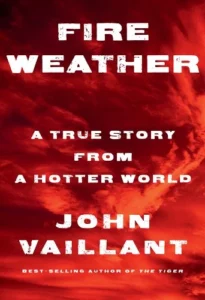
Early this summer, smoke from wildfires raging across Canada, including its northeastern region, blanketed much of the United States. In New York, residents were exposed to a noxious orange fog causing it to become, briefly, the city with the world’s worst air. The reprieve of cleaner oxygen once the fog lifted was to be short-lived: wildfires are not one-offs, but seasonal. And because of their growing frequency and size, more smoke would inevitably come.
Though fire is natural to the regeneration cycle of Canadian boreal forests, normally occurring every half century or so, climate change has made for dry conditions called “fire weather,” a phenomenon that the Canadian American nature journalist John Vaillant explores in his new book Fire Weather: A True Story From a Hotter World (subtitled The Making of a Beast in Canadian editions). While its focus is on the fires that ravaged the Albertan city of Fort McMurray and its surroundings in the later spring and summer of 2016, its insights seem prescient today and for a future when Canadian wildfires and their consequences may become an unfortunate aspect of life for many living in the North American continent.
The Fort MacMurray fires caused the Alberta’s largest ever fire evacuation, with an estimated 88,000 people out of their homes. It was also the country’s costliest disaster, with damages amounting to $9.9 billion Canadian dollars. By the time of its extinguishment in early August of that year, it had spread to the neighboring province of Saskatchewan and burned nearly 1,250,000 acres. Its intensity can be traced to its to admixture of geography—the city was founded on what are known as the Canadian oil sands, some of the largest deposits in the country—climate change, and human error.
Oil sand is not crude oil but bitumen, a tar-like substance that can be distilled into petroleum. The first oil sands projects there began in 1964 and ‘Fort Mac’ was incorporated as a municipality in 1980, eventually becoming one of the largest and richest oil towns in North America. The prosperity of the industry allowed Fort McMurray’s residents to enjoy comfortable lives—and Canada’s economy has benefited too. Canada is the world’s fourth largest oil producer and third largest exporter, with almost half of all Canadian oil imports bound to America—and almost 90 percent of that oil originates in Fort McMurray.
The boreal forests around the town do habitually burn, and its residents were used to seeing flames over their skies in summer months. When the fire that would become a superfire was first reported on May 3, municipal authorities treated it as another ordinary wildfire. So too did its residents. But this fire, suspected to have started by humans in a nearby campground and fueled by high and dry temperatures, caught emergency responders off-guard. An evacuation order was only called after the fire had moved into the suburbs. One resident told Vaillant that he saw a tower of black smoke billowing over his suburban neighbourhood of Beacon Hill at 1 p.m. that day, but it wasn’t until an hour later, when the fire was literally burning down his street, that an evacuation order was issued.
What Fire Weather effectively captures is just how hard it can be to react logically to a crisis caused by natural forces and human induced climate change and carbon emissions. As much as we recognize them, the inability to mentally process it even as the threat is literally in our own backyard allows for ineffective and absurd behavior. Valliant recounts the story of one of the last holdouts of evacuation, who tried to protect his home with a fire extinguisher. Vaillant chalks this up to the Lucretius problem—our ineptitude to imagine worst-case scenarios beyond those we’ve experienced firsthand. Its why in a town used to forest fires, the delay in evacuation could be attributed to its own people who were unable to grasp that this particular fire was any different than what they were used to.
Miraculously, no lives were lost, instead 2,400 homes and businesses were consumed or damaged beyond repair. With Fire Weather, Vaillant isn’t out to tell a tragedy but a cautionary tale. But it stops short of prescribing solutions to Canada’s growing wildfire problems, and does not foresee its their larger impact upon the continent as they continue into the present. Rather he suggestions we assimilate legal policy already in use elsewhere, and points to 2015 Friends of the Earth legal case in the Netherlands which sought to hold Shell accountable for curbing emissions. But while the European Union as a whole made such commitments legally binding in 2021, similar North American “green deals” remain in debate.
Vaillant’s journalism is best shown through the powerful firsthand accounts of fire, and the conversational science he layers throughout the book. What is clear is that we must prepare to reimagine the worst case of any climate-related scenario if we don’t do something to curb them.




